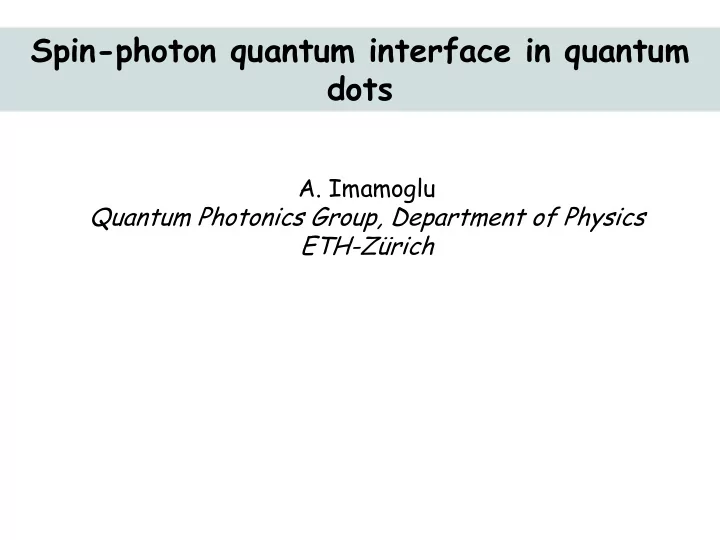

Spin-photon quantum interface in quantum dots A. Imamoglu Quantum Photonics Group, Department of Physics ETH-Zürich
Spin-photon quantum interface • GaAs based semiconductors exhibit highly efficient spin-dependent optical transitions. • Photonic nanostructures allow for efficient extraction of photons (Lukin).
Resonant quantum dot Spectroscopy From laser Polarization filter To detector Polarization optics NA=0.65 Spot size ≈1µm Magnet Piezo positioner GaAs Liquid He InGaAs GaAs
Strong spin-polarization correlations: Faraday geometry ( B ext = B z ) Γ : spontaneous emission rate Ω : laser coupling (Rabi) frequency Γ Ω + Ω − QD with a spin-up (down) electron only absorbs and emits σ + ( σ -) • photons – a recycling transition similar to that used in trapped ions. ⇨ Spin measurement
Strong spin-polarization correlations: Faraday geometry ( B ext = B z ) Γ Ω + Ω − QD with a spin-up (down) electron only absorbs and emits σ + ( σ -) • photons – a recycling transition similar to that used in trapped ions. ⇨ Spin measurement An off-resonant σ + laser causes ac- Stark shift only for the |↑> state, • acting as an effective magnetic field along the z-direction.
Spin rotation using off-resonant circularly polarized lasers • External field along x (B ext = B x ): quantization axis orthogonal to the laser-induced effective field Awschalom, Yamamoto
Different selection rules in Voigt geometry ( B ext = B x ) Excitation of a trion state results in either emission of a H polarized red photon to |↓> state or a V polarized blue photon to |↑> state, with equal probability.
Different selection rules in Voigt geometry ( B ext = B x ) Excitation of a trion state results in either emission of a H polarized red photon to |↓> state or a V polarized blue photon to |↑> state, with equal probability. ⇒ Spin-photon entanglement: potentially near-determinsitic entanglement generation at ~1 GHz rate Similar results by Yamamoto group; earlier work by Monroe,Lukin
Procedure for spin-photon entanglement generation Entanglement π Rotation generation Spin measurement/preparation time t = 0 Repetition period = 13 ns
Time resolved resonance fluorescence (RF) Partially suppressed Time-resolved laser reflection counts RF measurements 5 ns 1.2 ns spin puming 4 ps entanglement pulse Rotation pulse
Spin measurement and pumping ↓ ~2 photons/pulse. ↑ Nothing . • The detection of a photon shows the spin is in the state ↓ • At the end of the pulse, the spin is ↑ prepared in
Measurement of classical correlations An additional π -pulse (dashed curve) is applied to realize a heralded measurement in the spin-up state. Identical (unconditional) counts for red and blue photons confirm the selection rules. The g(2) measurement shows that for the [1.2ns, 1.64ns] time range, probability of two-photon emission is negligible. A spin down (up) measurement event ensures that the detected photon is red (blue). F1=0.87+/ -0.09 in the computational basis measure.ment
Measurement of classical correlations An additional π -pulse (dashed curve) is applied to realize a heralded measurement in the spin-up state. Identical (unconditional) counts for red and blue photons confirm the selection rules. The g(2) measurement shows that for the [1.2ns, 1.64ns] time range, probability of two-photon emission is negligible. A spin down (up) measurement event ensures that the detected photon is red (blue). F1=0.87+/ -0.09 in the computational basis measure.ment
Measurement of classical correlations An additional π -pulse (dashed curve) is applied to realize a heralded measurement in the spin-up state. Identical (unconditional) counts for red and blue photons confirm the selection rules. The g(2) measurement shows that for the [1.2ns, 1.64ns] time range, probability of two-photon emission is negligible. A spin down (up) measurement event ensures that the detected photon is red (blue). F1=0.87+/ -0.09 in the computational basis measure.ment
Measurement of classical correlations An additional π -pulse (dashed curve) is applied to realize a heralded measurement in the spin-up state. Identical (unconditional) counts for red and blue photons confirm the selection rules. The g(2) measurement shows that for the [1.2ns, 1.64ns] time range, probability of two-photon emission is negligible. A spin down (up) measurement event ensures that the detected photon is red (blue). F1=0.87 ± 0.05 in the computational basis measure.ment
Measurement of quantum correlations - An additional π /2 or 3 π /2- pulse (dashed curve) is applied to measure the spin in |↑> ± |↓>. - The data in b & c shows the coincidence measurement when π /2-pulse is applied. - The data in d & e shows the coincidence measurement when 3 π /2-pulse is applied. - F2=0.46+/ - 0.04 in the rotated basis measurement
Measurement of quantum correlations - An additional π /2 or 3 π /2- pulse (dashed curve) is applied to measure the spin in |↑> ± |↓>. - The data in b & c shows the coincidence measurement when π /2-pulse is applied. - The data in d & e shows the coincidence measurement when 3 π /2-pulse is applied. ⇒ Photon generation events at different times correspond to a measurement of the photonic - F2=0.46+/ - 0.04 in the rotated wave-function in different basis. basis measurement
Measurement of quantum correlations - An additional π /2 or 3 π /2- pulse (dashed curve) is applied to measure the spin in |↑> ± |↓>. - The data in b & c shows the coincidence measurement when π /2-pulse is applied. - The data in d & e shows the coincidence measurement when 3 π /2-pulse is applied. - F2=0.46 ± 0.04 in the rotated basis measurement; overall fidelity F = 0.67 ± 0.05
Outlook - Teleportation from a single photon to a solid- state spin - Spin-Spin entanglement
Thanks to • Weibo Gao • Emre Togan, Parisa Fallahi, Javier Sanchez
Recommend
More recommend